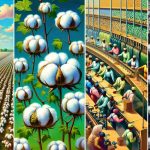I've always wondered what bamboo is made of. It's mostly made up of cellulose, hemicellulose, and lignin. These components give bamboo its incredible strength and flexibility. Cellulose is key for its structural support and is also biodegradable, making bamboo an eco-friendly option. Hemicellulose adds to that flexibility, while lignin boosts the durability. Also, bamboo contains silica, which protects it from pests and fungal attacks. It's fascinating to see how these natural elements make bamboo such a sustainable and versatile material. There's a lot more to discover about how these elements are used in various products!
Table of Contents
Key Takeaways
- Bamboo is primarily composed of cellulose, which provides strength and flexibility.
- It also contains hemicellulose, which enhances its structural support and durability.
- Lignin is another major component, increasing bamboo's tensile strength and durability.
- Silica in bamboo helps protect it from pests and fungal attacks.
- These components make bamboo a biodegradable and sustainable material.
Composition of Bamboo
Bamboo is mostly made up of cellulose, hemicellulose, and lignin, which give it strength and stiffness. These components are like the building blocks that keep bamboo tough yet flexible enough to sway without breaking. Let's dive a bit deeper into what each part does.
Cellulose is the main player; it's what makes up the majority of bamboo's structure and helps it stand tall. Hemicellulose works alongside cellulose, supporting the network that holds everything together, while lignin acts as a natural glue that binds these fibers, adding to the overall rigidity.
Now, the bamboo fibers, specifically the bast fibers, are really interesting. These fibers run along the length of the bamboo and are key to its ability to bend without snapping – think of them as the muscle fibers in your body. Their arrangement and the way they weave through the cellulose framework give bamboo its unique combination of strength and flexibility.
Another cool component is silica. This mineral is found throughout the bamboo and serves as a protector, warding off pests and fungal attacks. That's why bamboo can thrive without much pest control, making it not only strong but also a low-maintenance option for various uses.
Bamboo Cellulose Explained
Let's take a closer look at cellulose, the powerhouse that gives bamboo its remarkable strength and flexibility. This component isn't just a part of bamboo's structure; it's what makes bamboo so versatile and dependable.
Bamboo cellulose, in particular, has a few standout features:
- Strength and Flexibility: The high cellulose content in bamboo provides not just toughness, but also the flexibility that's essential for a wide range of uses, from construction materials to soft textiles.
- Eco-Friendly: Since it's biodegradable and renewable, bamboo cellulose is a champion for green living. It breaks down naturally and can be regrown quickly, minimizing environmental impact.
- Versatility in Products: You'll find bamboo cellulose in everything from plush fabrics to sturdy building supplies. Its adaptability is truly unmatched.
- Extraction Processes: To get this valuable cellulose, bamboo undergoes methods like pulping or enzymatic hydrolysis, which transform the raw bamboo into useful materials.
Understanding bamboo cellulose is crucial if you're looking into eco-friendly and renewable resources. Its high cellulose content isn't just good for the planet; it's a game-changer for sustainable manufacturing.
Lignin in Bamboo
After exploring the cellulose in bamboo, I'll now cover another key component: lignin. This stuff is a complex organic polymer that gives bamboo its structure. I found out that lignin is a major player in making bamboo tough and durable. It's what gives bamboo its impressive tensile strength, letting it handle a lot of stress without breaking.
Now, the amount of lignin can vary between different bamboo species, and this variation significantly affects their properties. Some types might be sturdier than others, purely based on their lignin content. This makes understanding lignin composition super important for anyone looking to use bamboo, especially if you're eyeing it as a sustainable alternative to more traditional materials. Here's a quick table to break down the basics of lignin in bamboo:
| Aspect | Details | Importance |
|---|---|---|
| Composition | Organic polymer | Core structural component |
| Impact on Bamboo | Increases tensile strength and durability | Crucial for performance |
| Variability | Differs among species | Affects material choice |
| Sustainability | Makes bamboo a renewable resource | Eco-friendly option |
| Application | Essential for product optimization | Key in industrial use |
Role of Hemicellulose
Now, let's talk about the role of hemicellulose in bamboo. This stuff is really important because it acts like glue, holding the cellulose fibers together which gives bamboo its strength and flexibility.
We'll look at how it's built chemically and what this means for bamboo's structure.
Hemicellulose Structural Functions
Hemicellulose in bamboo plays a crucial role, giving the plant its necessary strength and flexibility to handle stresses like wind and bending. Here's what I've learned about how hemicellulose contributes to the bamboo plant:
- Structural Support: Hemicellulose weaves into the cell walls, significantly boosting the bamboo's overall strength.
- Flexibility: It allows the bamboo to bend without breaking, which is vital for surviving in windy environments.
- Durability: This component is key to bamboo's ability to withstand various physical challenges over time.
- Physical Properties Variation: Depending on the hemicellulose content, different bamboo species exhibit unique physical characteristics, impacting their usability in construction and products.
Understanding these roles is essential for anyone looking to master the properties and potential uses of bamboo.
Hemicellulose Chemical Composition
Building on the structural roles of hemicellulose in bamboo, let's explore its chemical makeup and how this influences the plant's capabilities.
Hemicellulose is a complex carbohydrate that's key to bamboo's toughness. It basically glues the cellulose fibers together, enhancing the structural integrity that allows bamboo to endure various stresses like bending and compression.
The fascinating part? The amount of hemicellulose can vary among different bamboo species. This variation impacts their physical properties. More hemicellulose often means a stronger, sturdier bamboo. Understanding this component at a molecular level helps us grasp why some bamboo types are better for construction or crafts than others.
It's all about the mix of hemicellulose with other materials that determines how well bamboo performs.
Bamboo Textile Production
While exploring bamboo textile production, it's key to understand that this process transforms raw bamboo fibers into various fabric types. Here's what I've learned about the two main methods used:
- Mechanical Processing: This method retains the natural properties of bamboo, making the resulting bamboo fabric highly sustainable and eco-friendly. Mechanical processed bamboo doesn't rely on harmful chemicals, preserving both the environment and our health.
- Viscose Rayon Method: This is more common but involves chemicals like carbon disulfide, which are harmful to both workers and the environment. It breaks down bamboo cellulose and reconstructs it into a soft, versatile fabric. Despite its negative aspects, viscose rayon from bamboo is popular due to its silk-like softness.
Understanding these methods has made me realize that the way bamboo fabric is produced greatly impacts its environmental footprint and quality. Choosing mechanically processed bamboo products might be better for those of us who prioritize ecological and health concerns. Each choice in the production process matters, not just for the quality of our clothes, but for the well-being of our planet.
Bamboo in Paper Products
Bamboo is increasingly used to make eco-friendly paper products like toilet paper and coffee filters. It's not just about these everyday items, though. Bamboo pulp, the raw material derived from this fast-growing plant, is also turned into disposable cups and even baby diapers. Why bamboo? Well, it's super sustainable. This plant shoots up really quickly, making it a renewable resource that's tough to beat.
Bamboo paper products aren't only about being green; they're also top-notch in quality. The strength and durability of bamboo translate well into these products, meaning they don't just fall apart on you. Ever tried bamboo paper towels? They're a fantastic alternative to the usual ones, and they do the job without the guilt of harming the environment.
And speaking of the environment, using bamboo helps big time. Since it grows so fast, it's ready for harvest sooner, reducing the strain on our forests. It's a win-win. You get your paper products, and the planet gets a break. Plus, items like bamboo baby diapers are biodegradable, adding to their environmentally friendly creds. So, it's pretty clear why bamboo's a hit in the paper world!
Bamboo as Bioenergy Source
Now, let's talk about how bamboo can be turned into bioenergy.
We'll look into how much energy bamboo biomass can actually provide, the different technologies used to convert it, and the positive impacts this has on our environment.
It's pretty cool how this fast-growing plant could help us cut down on pollution and fossil fuel use.
Bamboo Biomass Potential
Exploring the potential of bamboo as a renewable bioenergy source, we find that it can be transformed into various forms like chips, charcoal, briquettes, and pellets for energy production. This use of bamboo biomass isn't only sustainable but also a smart move towards cleaner energy solutions.
Here's why bamboo is a great choice:
- Rapid Growth: Bamboo grows incredibly fast, making it a readily available resource.
- Reduces Carbon Footprint: Using bamboo helps in reducing reliance on fossil fuels.
- Environmental Conservation: Bamboo cultivation supports biodiversity and soil stability.
- Economic Benefits: It provides new income sources and job opportunities in rural areas.
Conversion Technologies
Let's dive into the different technologies used to convert bamboo into bioenergy.
First up, we've got gasification and pyrolysis, both super cool ways to break down bamboo into simpler compounds. They're all about turning that tough plant material into something that can generate heat and electricity—pretty handy, right?
Then there's fermentation, which is a bit like brewing your own bamboo biofuel.
And don't forget about plain old combustion; burning bamboo waste can directly produce heat and power up things that need electricity.
These conversion technologies are key because they let's tap into bamboo's energy potential while cutting down on fossil fuel use, making a sweet deal for sustainable energy solutions.
Environmental Impact Benefits
Bamboo often serves as a powerful bioenergy source, significantly reducing our carbon footprint by absorbing CO2 as it grows. When we look at how bamboo is used, the environmental benefits are pretty impressive. Here's a quick rundown:
- Greenhouse Gas Reduction: Bamboo captures a lot of CO2, helping to tackle greenhouse gas emissions.
- Minimal Resource Use: It grows well without much water or any pesticides, which is great for the planet.
- Soil Protection: Its roots help prevent erosion, keeping our soil stable.
- Supports Wildlife: Growing bamboo can also boost local biodiversity by providing habitats.
Plus, the bamboo bioenergy sector is creating jobs in both manufacturing processes and agriculture, which is a win for everyone!
Environmental Benefits
One of the major environmental benefits of bamboo is its ability to absorb more carbon dioxide than trees while releasing oxygen. This makes bamboo forests crucial in the fight against climate change. Plus, these forests are awesome because they need way less water and no nasty pesticides to grow. This makes bamboo a top-notch environmentally friendly choice, especially when you consider how many cool products are made from bamboo.
Speaking of products, have you heard of bamboo rayon? It's this soft material they make from bamboo, and it's just as eco-friendly. But it's not just about what bamboo can turn into; it's also about what it does for the planet. Bamboo plays a big part in stopping soil erosion. That's right, it keeps the ground right where it should be, which is super important for keeping our land healthy and useful.
And let's not forget the critters! Bamboo forests are like hotels for loads of wildlife. By keeping these forests thriving, we're making sure those animals have homes, which helps keep our ecosystems balanced and buzzing. So, yeah, bamboo's pretty much a green superhero!
Biodegradability of Bamboo
Continuing with the perks of bamboo, it's important to note its biodegradability, which significantly aids in reducing environmental waste. Bamboo is downright impressive when we talk about materials that don't just sit around for centuries after we're done with them.
Here's why bamboo is a champ in the biodegradability game:
- Natural Breakdown: Bamboo is biodegradable; it naturally decomposes into organic matter rather than lingering around.
- Quick Decomposition: It breaks down within 26 months. Compared to plastics and other non-degradable materials, that's super fast!
- Composting Benefits: Bamboo products can be composted. This means they can go back to earth and enrich the soil instead of clogging up landfills.
- Promotes Sustainable Practices: By choosing bamboo, you're not just buying a product; you're supporting environmentally friendly and sustainable practices.
Opting for bamboo products isn't just about using a trendy material; it's about making a conscious choice that aligns with caring for our planet. It's heartening to see how choosing something as simple as bamboo can contribute to a cycle that keeps our environment clean and healthy.
Bamboo's Sustainability
Let's dive into how sustainable bamboo really is. Bamboo, one of the fastest growing plants on the planet, is seriously impressive when we talk about sustainability. This powerhouse plant shoots up without needing much water or any pesticides at all. That's a huge plus for our environment.
Because bamboo grows so quickly, it's constantly being used to make everything from furniture to fabrics. This rapid growth means it can be harvested frequently without depleting resources or harming the ecosystem. What's more, bamboo forests are champs at sucking up carbon dioxide, which helps reduce those pesky greenhouse gases. They also protect our soil from erosion, keeping the land healthier for other crops or natural vegetation.
Now, let's talk about the communities who rely on bamboo. The bamboo industry isn't just about making high-quality bamboo products; it's a lifeline for many rural areas. It creates jobs and supports farmers, giving them a decent income. Plus, these bamboo spaces are vital for wildlife, offering them a safe habitat and helping maintain biodiversity.
Frequently Asked Questions
What Is Bamboo Material Made Of?
I've learned that bamboo material consists mainly of cellulose, hemicellulose, and lignin. These fibers are extracted and processed to create soft, breathable fabrics that are also hypoallergenic, making them great for sensitive skin.
Is Bamboo a Plant or a Wood?
Bamboo's definitely a plant, not wood. It's part of the grass family, which means it grows differently from trees, with hollow, segmented stems that are super flexible and don't have growth rings.
Is Bamboo a Healthy Material?
Yes, I definitely think bamboo's a healthy material! It's naturally antibacterial, hypoallergenic, and resists mold. Plus, it's breathable and doesn't need pesticides, making it perfect for both the planet and our health.
What Is Made Out of Bamboo?
I've learned that bamboo's used in a variety of products including furniture, textiles, kitchenware, and even construction. It's eco-friendly, grows quickly, and serves as a biodegradable alternative in many sustainable living choices.
- Digital Fabric Printing: How to Choose the Right Method - July 24, 2024
- Heat Transfer Printing: Essential Tips for Success - July 24, 2024
- Smart Fabrics: The Intersection of Fashion and Technology - July 24, 2024






